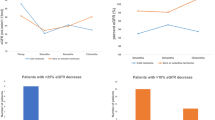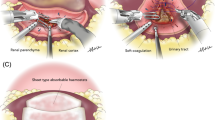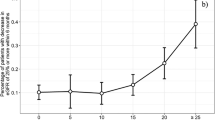Abstract
Purpose
To compare renal functional outcomes in patients with a small renal mass undergoing robot-assisted partial nephrectomy using warm ischemia (wRAPN) or open partial nephrectomy using cold ischemia (cOPN).
Methods
This study included 185 patients who underwent partial nephrectomy and were assessed by preoperative and postoperative diethylene triamine penta-acetic acid renal scintigraphy. Variables associated with postoperative operated-side glomerular filtration rate decrement (ΔGFR) were assessed using multivariate analysis. Exact 1:1 propensity score matching was performed using variables related to ΔGFR. Furthermore, 30 patients who underwent wRAPN were matched with 30 patients who underwent cOPN, and their differences in ΔGFR were calculated.
Results
Patients who underwent cOPN were older (p = 0.025) and had shorter ischemia time (p < 0.001) than patients who underwent wRAPN. Multivariate analysis showed that surgical method, preoperative operated-side GFR and RENAL nephrometry score were significantly associated with operated-side ΔGFR. After propensity score matching, postoperative 3-month (14.8 vs. 7.3 mL/min/1.73 m2, p = 0.057) and 1-year operated-side ΔGFR (11.4 vs. 2.8 mL/min/1.73 m2, p = 0.031) was higher after wRAPN than after cOPN in patients with ischemia time ≥25 min, but did not differ in patients with ischemia time <25 min. Within the matched pairs, cOPN resulted in lower operated-side ΔGFR than wRAPN in patients with ischemia time ≥25 min (−6.9 mL/min/1.73 m2, p = 0.047). Moreover, total GFR decrement was slightly lower with cOPN than with wRAPN (−7.2 mL/min/1.73 m2, p = 0.086).
Conclusions
cOPN was superior to wRAPN in patients with a small renal mass and ischemia time ≥25 min. However, wRAPN yielded renal functional outcomes comparable to those of cOPN when ischemia time was <25 min.

Similar content being viewed by others
References
Volpe A et al (2004) The natural history of incidentally detected small renal masses. Cancer 100(4):738–745
Ljungberg B et al (2015) EAU guidelines on renal cell carcinoma: 2014 update. Eur Urol 67(5):913–924
Campbell SC et al (2009) Guideline for management of the clinical T1 renal mass. J Urol 182(4):1271–1279
Rai BP et al (2012) Surgical management for upper urinary tract transitional cell carcinoma (UUT-TCC): a systematic review. BJU Int 110(10):1426–1435
Touijer K et al (2010) The expanding role of partial nephrectomy: a critical analysis of indications, results, and complications. Eur Urol 57(2):214–222
Kwon T et al (2015) Renal function is associated with nephrometry score after partial nephrectomy: a study using diethylene triamine penta-acetic acid (DTPA) renal scanning. Ann Surg Oncol 22(Suppl 3):1594–1600
Volpe A et al (2015) Renal ischemia and function after partial nephrectomy: a collaborative review of the literature. Eur Urol 68(1):61–74
Thompson RH et al (2007) The impact of ischemia time during open nephron sparing surgery on solitary kidneys: a multi-institutional study. J Urol 177(2):471–476
Porpiglia F et al (2012) The effects of warm ischaemia time on renal function after laparoscopic partial nephrectomy in patients with normal contralateral kidney. World J Urol 30(2):257–263
Patel AR, Eggener SE (2011) Warm ischemia less than 30 minutes is not necessarily safe during partial nephrectomy: every minute matters. Urol Oncol 29(6):826–828
Russo P (2010) Partial nephrectomy for renal cancer (part II): the impact of renal ischaemia, patient preparation, surgical approaches, management of complications and utilization. BJU Int 105(11):1494–1507
Bi L et al (2013) Robotic partial nephrectomy for renal tumors larger than 4 cm: a systematic review and meta-analysis. PLoS ONE 8(10):e75050
Zhang X et al (2013) Comparison of peri-operative outcomes of robot-assisted vs. laparoscopic partial nephrectomy: a meta-analysis. BJU Int 112(8):1133–1142
Sharma V, Margreiter M (2013) Partial nephrectomy: Is there still a need for open surgery? Curr Urol Rep 14(1):1–4
Song C et al (2011) Followup of unilateral renal function after laparoscopic partial nephrectomy. J Urol 186(1):53–58
Laviana AA, Hu JC (2014) Current controversies and challenges in robotic-assisted, laparoscopic, and open partial nephrectomies. World J Urol 32(3):591–596
Ghani KR et al (2014) Practice patterns and outcomes of open and minimally invasive partial nephrectomy since the introduction of robotic partial nephrectomy: results from the nationwide inpatient sample. J Urol 191(4):907–912
Rogers CG et al (2013) Robotic partial nephrectomy with cold ischemia and on-clamp tumor extraction: recapitulating the open approach. Eur Urol 63(3):573–578
Shikanov S et al (2010) Microparticulate ice slurry for renal hypothermia: laparoscopic partial nephrectomy in a porcine model. Urology 76(4):1012–1016
Weld KJ et al (2007) Feasibility of laparoscopic renal cooling with near-freezing saline irrigation delivered with a standard irrigator aspirator. Urology 69(3):465–468
Simmons MN, Fergany AF, Campbell SC (2011) Effect of parenchymal volume preservation on kidney function after partial nephrectomy. J Urol 186(2):405–410
Porter J (2015) Renal ischemia during partial nephrectomy: Does every minute still count? Eur Urol 68(1):75–76
Lee S et al (2011) Open versus robot-assisted partial nephrectomy: effect on clinical outcome. J Endourol 25(7):1181–1185
Simhan J et al (2012) Perioperative outcomes of robotic and open partial nephrectomy for moderately and highly complex renal lesions. J Urol 187(6):2000–2004
Simone G et al (2015) Indications, techniques, outcomes, and limitations for minimally ischemic and off-clamp partial nephrectomy: a systematic review of the literature. Eur Urol 68(4):632–640
Ficarra V et al (2012) Predictors of warm ischemia time and perioperative complications in a multicenter, international series of robot-assisted partial nephrectomy. Eur Urol 61(2):395–402
Author information
Authors and Affiliations
Corresponding author
Ethics declarations
Conflict of interest
The authors declare that they have no conflict of interest.
Rights and permissions
About this article
Cite this article
Yoo, S., Lee, C., Lee, C. et al. Comparison of renal functional outcomes in exactly matched pairs between robot-assisted partial nephrectomy using warm ischemia and open partial nephrectomy using cold ischemia using diethylene triamine penta-acetic acid renal scintigraphy. Int Urol Nephrol 48, 687–693 (2016). https://doi.org/10.1007/s11255-016-1220-4
Received:
Accepted:
Published:
Issue Date:
DOI: https://doi.org/10.1007/s11255-016-1220-4




